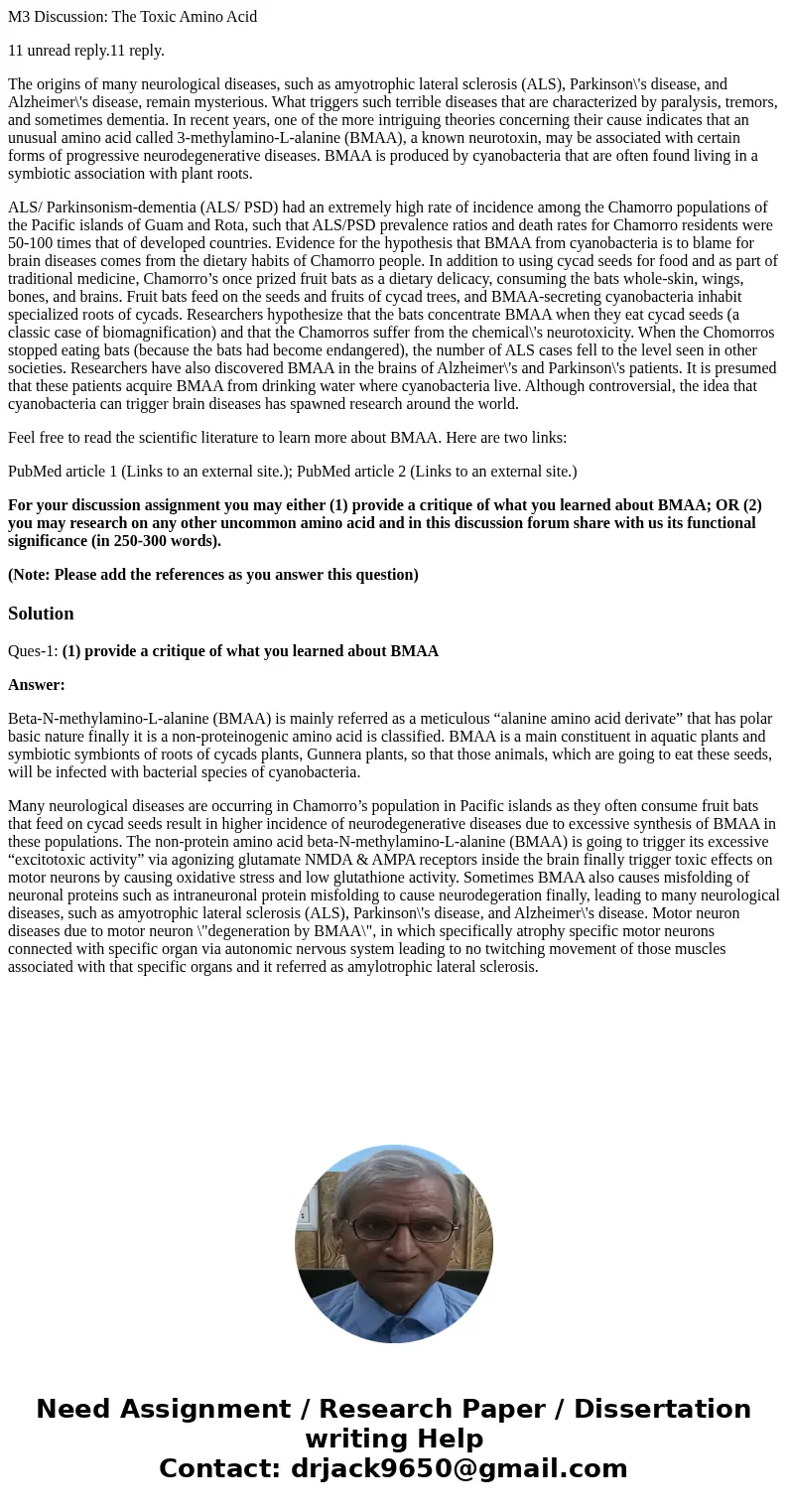M3 Discussion The Toxic Amino Acid 11 unread reply11 reply T
M3 Discussion: The Toxic Amino Acid
11 unread reply.11 reply.
The origins of many neurological diseases, such as amyotrophic lateral sclerosis (ALS), Parkinson\'s disease, and Alzheimer\'s disease, remain mysterious. What triggers such terrible diseases that are characterized by paralysis, tremors, and sometimes dementia. In recent years, one of the more intriguing theories concerning their cause indicates that an unusual amino acid called 3-methylamino-L-alanine (BMAA), a known neurotoxin, may be associated with certain forms of progressive neurodegenerative diseases. BMAA is produced by cyanobacteria that are often found living in a symbiotic association with plant roots.
ALS/ Parkinsonism-dementia (ALS/ PSD) had an extremely high rate of incidence among the Chamorro populations of the Pacific islands of Guam and Rota, such that ALS/PSD prevalence ratios and death rates for Chamorro residents were 50-100 times that of developed countries. Evidence for the hypothesis that BMAA from cyanobacteria is to blame for brain diseases comes from the dietary habits of Chamorro people. In addition to using cycad seeds for food and as part of traditional medicine, Chamorro’s once prized fruit bats as a dietary delicacy, consuming the bats whole-skin, wings, bones, and brains. Fruit bats feed on the seeds and fruits of cycad trees, and BMAA-secreting cyanobacteria inhabit specialized roots of cycads. Researchers hypothesize that the bats concentrate BMAA when they eat cycad seeds (a classic case of biomagnification) and that the Chamorros suffer from the chemical\'s neurotoxicity. When the Chomorros stopped eating bats (because the bats had become endangered), the number of ALS cases fell to the level seen in other societies. Researchers have also discovered BMAA in the brains of Alzheimer\'s and Parkinson\'s patients. It is presumed that these patients acquire BMAA from drinking water where cyanobacteria live. Although controversial, the idea that cyanobacteria can trigger brain diseases has spawned research around the world.
Feel free to read the scientific literature to learn more about BMAA. Here are two links:
PubMed article 1 (Links to an external site.); PubMed article 2 (Links to an external site.)
For your discussion assignment you may either (1) provide a critique of what you learned about BMAA; OR (2) you may research on any other uncommon amino acid and in this discussion forum share with us its functional significance (in 250-300 words).
(Note: Please add the references as you answer this question)
Solution
Ques-1: (1) provide a critique of what you learned about BMAA
Answer:
Beta-N-methylamino-L-alanine (BMAA) is mainly referred as a meticulous “alanine amino acid derivate” that has polar basic nature finally it is a non-proteinogenic amino acid is classified. BMAA is a main constituent in aquatic plants and symbiotic symbionts of roots of cycads plants, Gunnera plants, so that those animals, which are going to eat these seeds, will be infected with bacterial species of cyanobacteria.
Many neurological diseases are occurring in Chamorro’s population in Pacific islands as they often consume fruit bats that feed on cycad seeds result in higher incidence of neurodegenerative diseases due to excessive synthesis of BMAA in these populations. The non-protein amino acid beta-N-methylamino-L-alanine (BMAA) is going to trigger its excessive “excitotoxic activity” via agonizing glutamate NMDA & AMPA receptors inside the brain finally trigger toxic effects on motor neurons by causing oxidative stress and low glutathione activity. Sometimes BMAA also causes misfolding of neuronal proteins such as intraneuronal protein misfolding to cause neurodegeration finally, leading to many neurological diseases, such as amyotrophic lateral sclerosis (ALS), Parkinson\'s disease, and Alzheimer\'s disease. Motor neuron diseases due to motor neuron \"degeneration by BMAA\", in which specifically atrophy specific motor neurons connected with specific organ via autonomic nervous system leading to no twitching movement of those muscles associated with that specific organs and it referred as amylotrophic lateral sclerosis.

 Homework Sourse
Homework Sourse